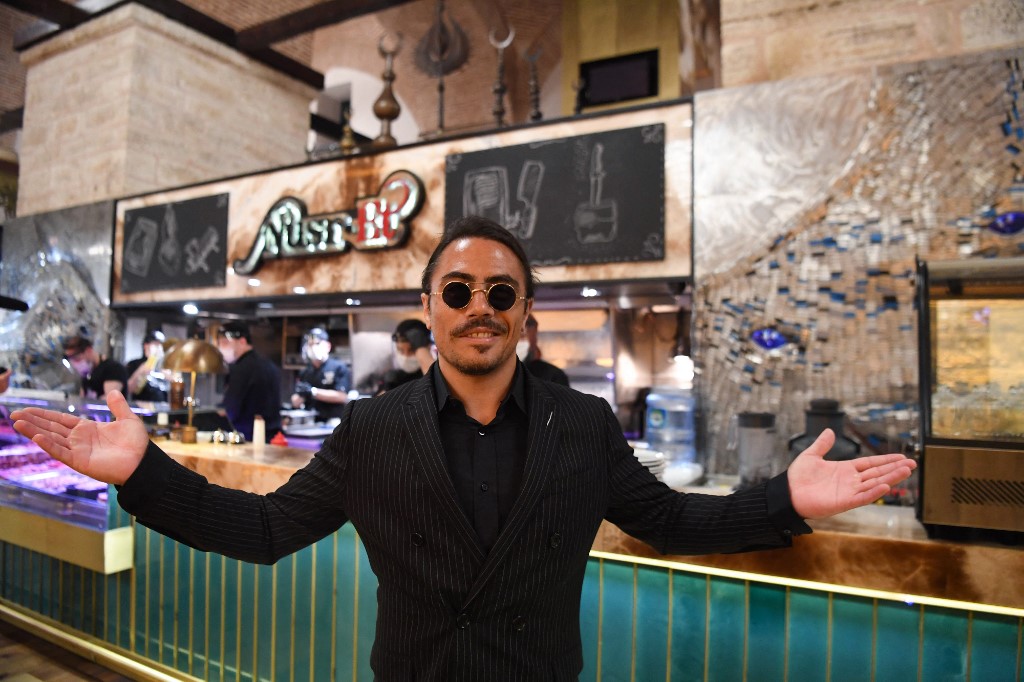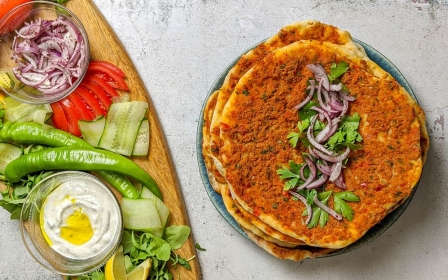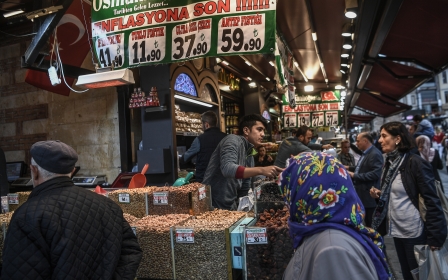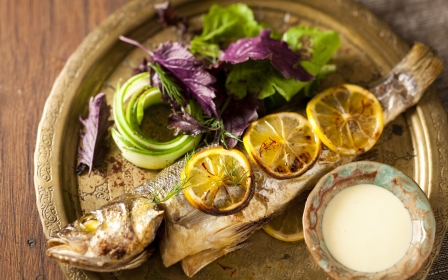From Salt Bae to CZN Burak, meet Turkey's superstar food influencers

Coming hot on the heels of former US President Donald Trump's inauguration in January 2017, a short video of a coiffured Turkish barbeque chef preparing a steak for customers went viral.
Armed with the expressionless demeanour of a hitman, an impression accentuated by his choice of eyewear, and an air of flamboyant extravagance, exemplified by his salt sprinkling flourish to conclude the performance, the image of Nusret Gokce quickly became one of the year's most memorable memes.
New MEE newsletter: Jerusalem Dispatch
Sign up to get the latest insights and analysis on Israel-Palestine, alongside Turkey Unpacked and other MEE newsletters
The breakout moment for the chef, who has since exploited his fame to establish a chain of restaurants across the world, came amid a broader trend in Turkey: that of the chef as a performance artist.
Gokce, or Salt Bae, as he was baptised by the elders of the internet, is first among equals among a group of Turkish food influencers, who count their social media followers in the millions.
While Gokce ranks highest, thanks in part to his talent for attracting regular media headlines and viral videos that mostly involve meat slapping, others follow not far behind.
They include Burak Ozdemir, a chef known for smiling into camera as he chops ingredients without endangering his fingers, and the affable Ercan Narinc, notable for his video roasting an entire camel.
The emerging popularity of the 'meat influencers' has not escaped the attention of critics. They encourage a culture of meat consumption at a time when meat production is responsible for 60 percent of food-based greenhouse emissions globally. The UN says that a shift to plant-based diets is one way of combatting runaway climate change but influencers promoting vegetarian or vegan lifestyles do not have the same following as their meat-eating counterparts just yet.
Notwithstanding those concerns, Turkey's established meat celebrities continue to grow in popularity, becoming household names across the region and on social media. Here, Middle East Eye profiles some of the most popular names.
Nusret Gokce or Salt Bae
Gokce is a 38-year-old miner’s son from Erzurum in eastern Anatolia. One of five children, news reports recount how Gokce left school at 10, and started working as a butcher's apprentice in the Kadikoy district of Istanbul at 13 to help take care of his family.
At 23, with 10 years of work experience under his belt and some savings, Gokce travelled to Argentina and then to New York. It's there that he is said to have studied steak restaurants in the hope of one day opening his own, which he did in 2010.
Turkish businessman Ferit Sahenk, head of the Dogus group, happened to eat at Gokce's restaurant in Istanbul and decided to invest, meaning Gokce was able to expand and open his meat houses across Turkey. The viral fame of the January 2017 video meant that there was also a market for the Salt Bae experience outside of his homeland.
With his latest opening in London, where steaks priced at £630 ($857) recently drew headlines, Gokce now has 15 diners across Turkey, the US and the Middle East.
Gokce, a man of few words, is a case study in understanding the power of social media and branding, turning a meme into real-world commercial success.
Once a young butcher's apprentice from the Anatolian hinterland, the chef now spends his days dressed in a tight fitting T-shirt with dark John Lennon-esque shades, meeting celebrities eager to pose with him as they do his iconic salt drop.
While many journalists have tried, few have succeeded in getting the chef to drop his persona, leading many to question whether it is an actual representation of his personality.
The performances with meat, whether rooted in his own personality or a character of his creation, have been described by some as sexy, and vulgar by others.
Some say behind the extravagance is a very mediocre product, describing the food itself as tasteless and overpriced, particularly at his US branches.
Restaurant critic Joshua David Stein said: “In a world where nebulous social media influencers get paid thousands of dollars for a post, is it really absurd to pay a mere $500 for Salt Bae to slip into our feed? No, it is human. And humans are idiots.”
With an Instagram following of 38 million - and millions more in the bank - Gokce is clearly not the idiot here and still retains the title of King of Turkey's Meat Men, at least for the time being.
Ercan Narinc
Another butcher turned restaurateur, Ercan Narinc, is from Malatya in the eastern Anatolia region of Turkey.
As a child he would help out at his family's butchers during the weekends and school holidays. By the time he was in his 20s, Narinc had moved to Istanbul to start his own business, trading in air conditioners, whilst also helping his older brother run his Istanbul restaurant.
In 1998, just a year after he had started his own business, he gave it up to open his own steakhouse, turning 6,500 square metres in Istanbul's Basaksehir neighbourhood into one of the world's biggest restaurants.
Diners can choose from carnivorous fare as varied as steak and chips to roast camel, but it's the humble burger for which Narinc is famous.
Islak burgers, or wet burgers, where the bun is soaked in a tomatoey-garlic sauce, have been part of the Turkish street food scene for years, but the western concept of a flat round burger between two halves of a bun is newer and that's what Narinc has capitalised on.
Noticing how burgers were becoming popular in Turkey as more international chains opened branches there, Narinc thought he could offer better, using local meat from Turkey's Thrace region.
Now Turkey’s largest domestic burger chain, with 55 branches, Narinc is also trying to curate his social media presence.
Followers of his Ercan Burger Instagram account, which has 2.2 million followers, will see Narinc regularly attending the opening of new branches of his burger joint in areas across Istanbul and the rest of Turkey.
Inaugurating each branch with a simple ribbon cutting followed with a few words of thanks to God, Narinc also has branches in Dubai and Miami, with plans to have 220 branches worldwide within the next two years.
His separate steakhouse account on Instagram has more than three million followers.
With a more down-to-Earth persona than Gokce, Narinc is not shy of spectacle and went viral with a video of himself roasting a camel in a huge outdoor oven.
Faruk Gezen
Gezen’s simple step-by-step cooking tutorials on YouTube, guide home-cooks on how to prepare restaurant-worthy seafood dishes, including BBQ fish wrapped in vine leaves and whole shrimps baked inside a melon.
In his most popular YouTube video, having amassed almost eight million views and earning him the title "chef-tuber", Gezen does not speak, nor is there any music – just silence and the sound of cooking. Other cooking videos on his instagram page have upbeat tunes played over them to appeal to the social media generation.
With his floppy blow-dried quiff and sculpted beard, each recipe ends with Gezen tasting his creation, followed by his trademark "OK" hand gesture signalling the food is on point. Gezen's magic formula is becoming popular with other chefs eager to carve out their own following.
Born in 1985 in Bitlis, just west of Lake Van, Gezen started cooking with his younger brother Mehmet, before setting up the Chef Bro's seafood restaurant. They are also proprietors of Deli Yengec (or Crazy Crab) in Ankara, offering a seafood-heavy menu alongside some meat dishes for the city's wealthy diners.
With 1.7 million followers on Instagram, Gezen has a fraction of Salt Bae's popularity so far but remains the undisputed king when it comes to seafood.
Burak Ozdemir or CZN Burak
Ozdemir was born to an Arab family in Hatay, near Turkey's border with Syria, to a father who owned a textile shop called Cinzano, from which Ozdemir's nickname CZN (Pronounced Che-Ze-Ne) is derived.
As a child, he learned how to cook from his grandfather, Zeytindali, later taking up cooking as a profession and opening up his own restaurant.
Hatay Medeniyetler Sofrasi serves large portions of traditional Turkish and Middle Eastern dishes. The family now own a chain of six restaurants in Turkey and one in Dubai.
Like his fellow influencers, Ozdemir's success is just as much down to his talent for social media promotion as it is about the food.
In his video, CZN wears a perma-grin with his eyes fixed on the camera as he chops away at ingredients, a slapstick formula that has won him more than 28 million Instagram followers and close to 50 million on TikTok. His other specialty is preparing super-sized portions of his dishes in equally large kitchenware.
At his restaurant near Istanbul's Taksim Square, tourists can be seen posing for pictures next to a lifesize cutout of the chef placed at the doorway.
Perhaps second only to Salt Bae in terms of popularity, when asked in an interview if he is competing with Gokce, Ozdemir replied: "Nusret represents the society and I represent the people."
Ahmet Cicek or Midyeci Ahmet
Cicek, also known by the name of his restaurant, Midyeci Ahmet (which equates to Ahmet the Mussel guy) comes from the Turkish city of Mardin in the south-east of the country.
As a child, he moved to Istanbul with his parents who earned a living selling mussels. The family trade passed down to a young Cicek who started selling mussels himself in front of the gates of his own school when he was six.
By the time he was 15, he had met many local celebrities through his mussell stall and slowly developed his business.
After a series of setbacks, Cicek was finally able to set up a thriving shop in Istanbul's Besiktas district and now also owns a mussel factory in Greece from where he imports the shellfish.
Now with 30 branches in Turkey, serving his signature dish of stuffed mussels served with plenty of lemon, Cicek plans to open further branches in Baku, Mannheim, Cologne and Berlin.
Middle East Eye delivers independent and unrivalled coverage and analysis of the Middle East, North Africa and beyond. To learn more about republishing this content and the associated fees, please fill out this form. More about MEE can be found here.






